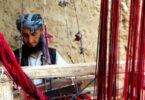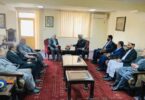Christopher Jones
KABUL: In March, I went to Chicken Street in Kabul, a well-known shopping stop for those Americans and foreigners who are allowed to venture outside the Green Zone. In one of my favorite shops, I noticed a tray of silver in one of the display cases. As the shopkeeper splayed the trinkets out on the glass, he uncovered a single gold disc, slightly larger than the others. I couldn’t help but laugh when I read the inscription: “Chief Petty Officer’s Mess.” Here in the heart of Kabul, the capital of landlocked Afghanistan, I’d found a challenge coin from a group of American Navy officers who decided their tradition of shared meals warranted permanent commemoration. Between 2010 and 2011, these nameless chiefs — “tried, tempered & trued,” according to the coin’s engraving — had dined as one. I too had spent that time in Afghanistan, though there was no coin honoring my unit’s meals in the mud-brick compound we called home.
Challenge coins are beloved by those who commission them — usually American military officers or staff noncommissioned officers. The name comes from their original purpose in Special Forces units, where they seem to have originated: If challenged to prove what unit they were in, soldiers could pull out their coins as proof. Once exclusively an Army phenomenon, the practice expanded to the other services during the global war on terror. The coins are typically handed out to members of a unit after a deployment, or given as ceremonial gifts to partnered units and allies, tchotchkes from a deployment spent in combat (or at least in the same country as combat). Unlike official Defense Department-issued medals, they are a rare chance for self-expression for career military people who want to memorialize themselves and their actions, a tangible way of thanking yourself for your own service by showering those around you with tokens noting your rank and leadership. Yet despite this unique opportunity to wax artistic, most challenge coins look incredibly similar: copper or gold-plated, a flag or unit crest on one side and an eagle or some other symbol of military strength on the other. This uniformity is not by Defense Department order or field-manual regulation, but by unconscious consensus. Even these self-important attempts to memorialize small moments spent prolonging America’s longest conflict can’t escape the same myopic approach we applied to fighting the war and “winning hearts and minds” in Afghanistan.
The same challenge coins I was given as a Marine can be bought for less than $2 on Chicken Street — if you’re a seasoned haggler and speak a little Dari. If you don’t, you’ll be treated the way all Americans have been treated by Afghans since 2001. “How much do you want to pay?” is the question almost all shopkeepers on Chicken Street know how to ask in English. They’re hoping that you’re a miniature version of the America they know: flush with cash, short on understanding, scared of the locals and eager to buy something to show for your time in their country. If they agree to the price you offer without any haggling, you’ve undoubtedly overpaid.
The coins on display here were dull from handling and time, but in another shop I found one that had not lost its luster. On one side, an enameled red banner with three white stars — the official flag of an American three-star general — was surrounded by a proclamation: “Presented For Excellence By Commanding General CFC-A,” and “Freedom 06.” Finding a coin from 2006 felt like uncovering an ancient relic; this medallion was handed out before Barack Obama was elected president, before counterinsurgency doctrine and “a government in a box,” before the surge, before Americans really understood just how far we were from “mission accomplished” in Iraq.
I could imagine the confidence that might have accompanied this coin’s being handed out — especially if it happened in the first months of 2006. The United States was preparing to hand over responsibility for security in Afghanistan to a NATO-led international force. The Taliban was active in the provinces — there was no denying the roadside bombs, firefights and suicide attacks. But in Kabul, the Western-backed government of President Hamid Karzai was confirming cabinet ministers and voting on legislation, George W. Bush paid a surprise visit for the ribbon-cutting at the new United States Embassy and The New York Times was praising “Kabul’s new status as an emerging, if risky, destination for daring international travelers.” Dollars flowed from the American government into outstretched hands like manna from the heavens. The true miracle, though, was that once the money was handed over, the Americans stopped asking questions. Projects were left unfinished; some contractors simply took the money and ran. In the Marines I served under a first sergeant whose favorite saying was: “Inspect what you expect, otherwise the failure is yours.” That apparently didn’t apply to the American government, which blamed Afghans for the corruption that American negligence enabled.
I asked the shopkeeper where his stash of coins came from. He told me people bring them in to pawn, especially in the winter when money is scarce and buying wood and coal for heat becomes an urgent necessity. His English was strong; he told me he once worked as an interpreter for American forces. I wondered if he knew where his suppliers pawning the coins had gotten them — were they stolen from the bodies of fallen soldiers? Exhumed from the wreckage of detonated military vehicles? Rummaged from overrun patrol bases? The shopkeeper had an innocent explanation: The coins were sometimes presented to Afghans as a token of appreciation for their work as interpreters or contractors. But as the contracts dried up, hundreds of thousands of Afghans who relied on them for employment lost their livelihoods. Meaningless trinkets from American military officers who never knew their names must have been easy objects to part with. Afghans need bread, and you can’t eat souvenir coins.
Later that evening, I researched the general’s coin and concluded that it was most likely handed out by Lt. Gen. Karl Eikenberry, who oversaw the American-led coalition forces in Afghanistan from 2005 to 2007 and was appointed by President Obama as the American ambassador to Afghanistan in 2009. Today he is based at Stanford University and is a member of a handful of think tanks specializing in international relations. I sent him an email telling him that I had found his challenge coin on Chicken Street. He never responded.
For almost two decades, American military leaders cycled in and out of Afghanistan mostly on one-year deployments, a time frame far too short to accomplish much of anything. Mike Martin, author of “An Intimate War,” an exhaustively researched account of the violence in Afghanistan’s Helmand Province, told me in a recent phone call that we haven’t had a 20-year commitment in Afghanistan; “we’ve had 20 one-year commitments.” The immense and complicated project of rebuilding a shattered country needs long-term vision, but officers who know they’ll be leaving in a year are looking to score short-term results.
Unlike the military’s Vietnam-era leadership, which resorted to enemy body counts as a measure of success, officers in Afghanistan settled on a less controversial metric: spending. New leaders brought new budgets, and they needed to spend them to keep up appearances. With one-year deployments came a culture of buck passing, of leaving Afghanistan with a laundry list of “initiatives” and “reconstruction efforts” left half-finished. There’s the $34 million spent on a command center in Helmand that the Marine Corps asked not to be built in 2010, only for it to be inexplicably built by the Air Force in 2011, standing unused until it was handed over to the Afghan security forces in 2014. There’s the $250 million — or maybe as much as $280 million — spent between 2005 and 2018 to build 145 miles of road in the northwest. Three American presidents and 10 American commanding generals later, the road remains unfinished. Like the shopkeepers on Chicken Street, Afghan contractors asked the Americans “How much?” and pocketed the bloated sums they were offered.
The cyclical nature of our infrastructure failures has mirrored that of our strategic ones. The same problems that plagued combat operations in 2004 were still in place in 2010. The Afghan National Army remains undertrained, underequipped and unable to hold off the Taliban. Poor understanding of local politics enables corruption and bad intelligence. Bad intelligence enables bad operations, and bad operations lead to civilian casualties. American and Afghan Air Force strikes resulted in more than 1,000 civilian injuries and deaths last year, according to the United Nations, some 700 more than at the height of fighting in 2010.
The American military leadership in Afghanistan has often congratulated itself on new, innovative approaches to fighting the Taliban over nearly 18 years, but from the ground level they have felt like challenge coins: an engraved eagle here, an embossed dinosaur there, but the same coin at the end of the day. The best kind of challenge coin is the all-too-rare bottle opener, because functionality is anathema to military ornamentation, and because they tacitly acknowledge the fighting military’s dependence on alcohol to patch over the cognitive dissonance required to make a career out of the global war on terror. Their scarcity is doubly paradoxical considering one popular story of the origin of challenge coins: as something for Vietnam grunts to pull out at bars in Saigon to prove their combat-unit affiliation if they were questioned about it. I for one never witnessed any grunts from our more recent quagmire indulging in this ritual, and I spent four years at Marine bars in North Carolina. When I asked a few Army veterans if they’d ever used challenge coins for their supposed purpose, the responses ranged from, “Oh, yeah, those things were worthless trash” to a heartfelt explanation that some can hold real sentimental value.
Challenge coins represent everything my war in Afghanistan was not. They’re clean, bold, simple in their assertions. They symbolize an orderly war that existed only in the sterilized world of Defense Department public affairs and an American public happy to ignore the “good war” after Iraq. I’ve never found a challenge coin commemorating the time a roadside bomb killed two Marines from my company, inside an armored vehicle designed to protect them from exactly that kind of blast. I have yet to discover a challenge coin proudly commemorating the way an insightful Marine colonel’s initiative to encourage farmers in Helmand Province to grow cotton instead of opium poppies was torpedoed by U.S.A.I.D. bureaucrats who seemed to think Afghan cotton could threaten American cotton producers.
As negotiators try to end our participation in America’s longest war, it’s worth taking stock of what we’ll leave behind. Kabul, largely flattened during civil war in the 1990s, was rebuilt with American dollars. Today its uneven urban landscape and drastic gap between the rich and the poor are testaments to our scattershot approach to nation-building. It’s where our mark on the country will stand alongside those of its previous invaders. The capital city’s Mikrorayon neighborhood is famous for the squat, impenetrable concrete apartment complexes built by the Soviets in the 1980s. America’s biggest contribution — in the face of Kabul’s desperate need for housing — is hundreds or maybe even thousands of ornate multistory “poppy palaces” that poke up from behind their barbed-wire-topped walls. They are owned by contractors and warlords-turned-politicians; we didn’t build them, but we certainly paid for them.
On the outskirts of town, these mansions loom over refugee camps overflowing with Afghans who’ve fled fighting between the Taliban and American forces in their villages. Their shacks and mud compounds were not subsidized by American taxpayers. Mughal invaders who conquered Kabul in 1504 left a fortress on one of the city’s hills; it was occupied and then lost by the British, but its parapets are still standing tall more than 100 years later. A 15th-century castle in Herat stands on the site of an earlier one built by Alexander the Great in 330 B.C. Our bases have been largely dismantled, and those that remain have been reduced to a fraction of their former size. Everything about our presence in Afghanistan — military and civilian — reeks of the transient nature of our commitment to the country. Even Kabul’s Green Zone appears to have been designed with its own dismantling in mind. When America finally abandons Afghanistan, hardly a trace of our time there will remain. The billions in infrastructure projects are proving as dysfunctional and short-lived as the peace we said we’d bring. So perhaps it’s only fitting that our trinkets of war be relegated to hiding beneath Soviet medals for valor in a tiny graveyard of empires on Chicken Street, for sale at whatever price you’re willing to pay.
Courtesy: (New York Times)






